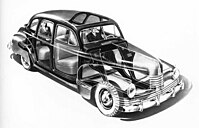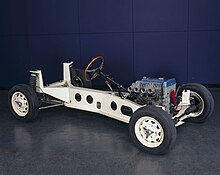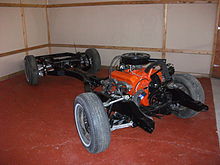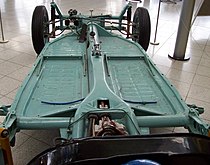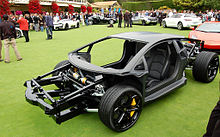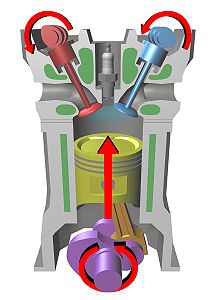Hello friends,
Today I am starting my blog with a new topic chassis. You can also check my old blogs for more details on automobiles.
So lets get started with the topic
A vehicle frame, also known as its chassis, is the main supporting structure of a motor vehicle to which all other components are attached, comparable to the skeleton of an organism.
Until the 1930s, virtually every (motor) vehicle had a structural frame, separate from the car's body. This construction design is known as body-on-frame. Since then, nearly all passenger cars have received unibody construction, meaning their chassis and bodywork have been integrated into one another. The last UK mass-produced car with a separate chassis was the Triumph Herald, which was discontinued in 1971. However, nearly all trucks, buses and pickups continue to use a separate frame as their chassis.
Typically the material used to construct vehicle chassis and frames is carbon steel; or aluminum alloys to achieve a more light-weight construction. In the case of a separate chassis, the frame is made up of structural elements called the rails or beams. These are ordinarily made of steel channel sections, made by folding, rolling or pressing steel plate.
There are three main designs for these. If the material is folded twice, an open-ended cross-section, either C-shaped or hat-shaped (U-shaped) results. "Boxed" frames contain chassis rails that are closed, either by somehow welding them up, or by using premanufactured metal tubing
C-shape
By far the most common, the C-channel rail has been used on nearly every type of vehicle at one time or another. It is made by taking a flat piece of steel (usually ranging in thickness from 1/8" to 3/16") and rolling both sides over to form a c-shaped beam running the length of the vehicle.
Hat
Hat frames resemble a "U" and may be either right-side-up or inverted with the open area facing down. Not commonly used due to weakness and a propensity to rust, however they can be found on 1936–1954 Chevrolet cars and some Studebakers.
Abandoned for a while, the hat frame gained popularity again when companies started welding it to the bottom of unibody cars, in effect creating a boxed frame.
Boxed
Originally, boxed frames were made by welding two matching C-rails together to form a rectangular tube. Modern techniques, however, use a process similar to making C-rails in that a piece of steel is bent into four sides and then welded where both ends meet.
On perimeter frames, the areas where the rails connect from front to center and center to rear are weak compared to regular frames, so that section is boxed in, creating what's known as torque boxes.
So named for its resemblance to a ladder, the ladder frame is one of the simplest and oldest of all designs. It consists of two symmetrical beams, rails, or channels running the length of the vehicle, and several transverse cross-members connecting them. Originally seen on almost all vehicles, the ladder frame was gradually phased out on cars in favor of perimeter frames and unitized body construction. It is now seen mainly on trucks. This design offers good beam resistance because of its continuous rails from front to rear, but poor resistance to torsion or warping if simple, perpendicular cross-members are used. Also, the vehicle's overall height will be greater due to the floor pan sitting above the frame instead of inside it.
I
al.).
A backbone chassis is a type of automobile construction chassis that
is similar to the body-on-frame design. Instead of a two-dimensional
ladder type structure, it consists of a strong tubular backbone (usually
rectangular in cross section) that connects the front and rear
suspension attachment areas. A body is then placed on this structure.
This is the design used for the full-size American models of General Motors in the late 1950s and early 1960s in which the rails from alongside the engine seemed to cross in the passenger compartment, each continuing to the opposite end of the crossmember at the extreme rear of the vehicle. It was specifically chosen to decrease the overall height of the vehicles regardless of the increase in the size of the transmission and propeller shaft humps, since each row had to cover frame rails as well. Several models had the differential located not by the customary bar between axle and frame, but by a ball joint atop the differential connected to a socket in a wishbone hinged onto a cross member of the frame.
The X-frame was claimed to improve on previous designs, but it lacked side rails and thus did not provide adequate side-impact and collision protection.This design was replaced by perimeter frames.
Similar to a ladder frame, but the middle sections of the frame rails sit outboard of the front and rear rails just behind the rocker / sill panels. This was done to allow for a lower floor pan, especially at the passenger foot wells, to lower the passengers' seating height and therefore reduce the overall vehicle height in passenger cars. This became the prevalent design for body-on-frame cars in the United States, but not in the rest of the world, until the uni-body gained popularity. It allowed for annual model changes introduced in the 1950s to increase sales, but without costly structural changes. As of 2014, there are no perimeter frame automobiles sold in the United States after the Ford Motor Company phased out the Panther platform in 2011, which ended the perimeter frame passenger car in the United States (the Chevrolet Corvette has used a variation of the perimeter frame since 1963 but its seventh generation variant has elements of the perimeter frame integrated with an internal endoskeleton which serves as a clamshell).
This is a modification of the perimeter frame or of the backbone frame, in which the passenger compartment floor, and sometimes also the luggage compartment floor have been integrated into the frame as loadbearing parts, for extra strength and rigidity. Neither floor pieces are simply sheet metal straight off the roll, but have been stamped with ridges and hollows for extra strength.
In a (tubular) spaceframe chassis, the suspension, engine, and body panels are attached to a three-dimensional skeletal frame of tubes, and the body panels have little or no structural function. In order to maximise rigidity and minimise weight, the design makes maximum use of triangles, and all the forces in each strut are either tensile or compressive, never bending, so they can be kept as thin as possible.
The first true spaceframe chassis were produced in the 1930s by Buckminster Fuller and William Bushnell Stout (the Dymaxion and the Stout Scarab) who understood the theory of the true spaceframe from either architecture or aircraft design.
A
subframe is a distinct structural frame component, to reinforce or
complement a particular section of a vehicle's structure. Typically
attached to a unibody or a monocoque, the rigid subframe can handle high
chassis forces and can transfer them evenly over a wide area of
relatively thin sheet metal of a unitized body shell. Subframes are
often found at the front or rear end of cars, and are used to attach the
suspension to the vehicle. A subframe may also contain the engine and
transmission. It is normally of box steel construction, but may be
tubular.
Thank You for viewing this blog.I think you all got some information about chassis. And for more information or knowledge keep on update or comment down below
THANK YOU
Today I am starting my blog with a new topic chassis. You can also check my old blogs for more details on automobiles.
So lets get started with the topic
A vehicle frame, also known as its chassis, is the main supporting structure of a motor vehicle to which all other components are attached, comparable to the skeleton of an organism.
Until the 1930s, virtually every (motor) vehicle had a structural frame, separate from the car's body. This construction design is known as body-on-frame. Since then, nearly all passenger cars have received unibody construction, meaning their chassis and bodywork have been integrated into one another. The last UK mass-produced car with a separate chassis was the Triumph Herald, which was discontinued in 1971. However, nearly all trucks, buses and pickups continue to use a separate frame as their chassis.
Functions
The main functions of a frame in motor vehicles are:- To support the vehicle's mechanical components and body
- To deal with static and dynamic loads, without undue deflection or distortion.
- These include:
- Weight of the body, passengers, and cargo loads.
- Vertical and torsional twisting transmitted by going over uneven surfaces.
- Transverse lateral forces caused by road conditions, side wind, and steering the vehicle.
- Torque from the engine and transmission.
- Longitudinal tensile forces from starting and acceleration, as well as compression from braking.
- Sudden impacts from collisions.
Construction
Frame rails
Typically the material used to construct vehicle chassis and frames is carbon steel; or aluminum alloys to achieve a more light-weight construction. In the case of a separate chassis, the frame is made up of structural elements called the rails or beams. These are ordinarily made of steel channel sections, made by folding, rolling or pressing steel plate.
There are three main designs for these. If the material is folded twice, an open-ended cross-section, either C-shaped or hat-shaped (U-shaped) results. "Boxed" frames contain chassis rails that are closed, either by somehow welding them up, or by using premanufactured metal tubing
C-shape
By far the most common, the C-channel rail has been used on nearly every type of vehicle at one time or another. It is made by taking a flat piece of steel (usually ranging in thickness from 1/8" to 3/16") and rolling both sides over to form a c-shaped beam running the length of the vehicle.
Hat
Hat frames resemble a "U" and may be either right-side-up or inverted with the open area facing down. Not commonly used due to weakness and a propensity to rust, however they can be found on 1936–1954 Chevrolet cars and some Studebakers.
Abandoned for a while, the hat frame gained popularity again when companies started welding it to the bottom of unibody cars, in effect creating a boxed frame.
Boxed
Originally, boxed frames were made by welding two matching C-rails together to form a rectangular tube. Modern techniques, however, use a process similar to making C-rails in that a piece of steel is bent into four sides and then welded where both ends meet.
Design features
While appearing at first glance as a simple hunk of metal, frames encounter great amounts of stress and are built accordingly. The first issue addressed is beam height, or the height of the vertical side of a frame. The taller the frame, the better it is able to resist vertical flex when force is applied to the top of the frame. This is the reason semi-trucks have taller frame rails than other vehicles instead of just being thicker.On perimeter frames, the areas where the rails connect from front to center and center to rear are weak compared to regular frames, so that section is boxed in, creating what's known as torque boxes.
Types
Ladder frame
So named for its resemblance to a ladder, the ladder frame is one of the simplest and oldest of all designs. It consists of two symmetrical beams, rails, or channels running the length of the vehicle, and several transverse cross-members connecting them. Originally seen on almost all vehicles, the ladder frame was gradually phased out on cars in favor of perimeter frames and unitized body construction. It is now seen mainly on trucks. This design offers good beam resistance because of its continuous rails from front to rear, but poor resistance to torsion or warping if simple, perpendicular cross-members are used. Also, the vehicle's overall height will be greater due to the floor pan sitting above the frame instead of inside it.
Unibody
The term unibody or unit body is short for unitized body, or alternatively unitary construction design. This engineering approach of a vehicle describes "of a vehicle, a one-piece frame and body structure" A "type of body/frame construction in which the body of the vehicle, its floor plan and chassis form a single structure. Such a design is generally lighter and more rigid than a vehicle having a separate body and frame." Traditional body-on-frame architectures has shifted to the lighter unitized body structure that is now used on most cars.I
al.).
Backbone tube
X-frame
This is the design used for the full-size American models of General Motors in the late 1950s and early 1960s in which the rails from alongside the engine seemed to cross in the passenger compartment, each continuing to the opposite end of the crossmember at the extreme rear of the vehicle. It was specifically chosen to decrease the overall height of the vehicles regardless of the increase in the size of the transmission and propeller shaft humps, since each row had to cover frame rails as well. Several models had the differential located not by the customary bar between axle and frame, but by a ball joint atop the differential connected to a socket in a wishbone hinged onto a cross member of the frame.
The X-frame was claimed to improve on previous designs, but it lacked side rails and thus did not provide adequate side-impact and collision protection.This design was replaced by perimeter frames.
Perimeter frame
Similar to a ladder frame, but the middle sections of the frame rails sit outboard of the front and rear rails just behind the rocker / sill panels. This was done to allow for a lower floor pan, especially at the passenger foot wells, to lower the passengers' seating height and therefore reduce the overall vehicle height in passenger cars. This became the prevalent design for body-on-frame cars in the United States, but not in the rest of the world, until the uni-body gained popularity. It allowed for annual model changes introduced in the 1950s to increase sales, but without costly structural changes. As of 2014, there are no perimeter frame automobiles sold in the United States after the Ford Motor Company phased out the Panther platform in 2011, which ended the perimeter frame passenger car in the United States (the Chevrolet Corvette has used a variation of the perimeter frame since 1963 but its seventh generation variant has elements of the perimeter frame integrated with an internal endoskeleton which serves as a clamshell).
Platform frame
This is a modification of the perimeter frame or of the backbone frame, in which the passenger compartment floor, and sometimes also the luggage compartment floor have been integrated into the frame as loadbearing parts, for extra strength and rigidity. Neither floor pieces are simply sheet metal straight off the roll, but have been stamped with ridges and hollows for extra strength.
Space frame
In a (tubular) spaceframe chassis, the suspension, engine, and body panels are attached to a three-dimensional skeletal frame of tubes, and the body panels have little or no structural function. In order to maximise rigidity and minimise weight, the design makes maximum use of triangles, and all the forces in each strut are either tensile or compressive, never bending, so they can be kept as thin as possible.
The first true spaceframe chassis were produced in the 1930s by Buckminster Fuller and William Bushnell Stout (the Dymaxion and the Stout Scarab) who understood the theory of the true spaceframe from either architecture or aircraft design.
Subframe
Thank You for viewing this blog.I think you all got some information about chassis. And for more information or knowledge keep on update or comment down below
THANK YOU




